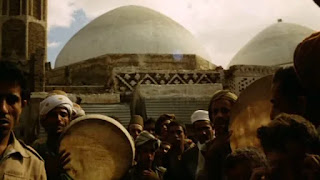The Walls of Sana'a (Pier Paolo Pasolini, 1971, Italy)
The Walls of Sana'a is a 1971 short documentary by Pier Paolo Pasolini. The film opens with shots of a field, and a man cracking a whip - whom we learn is a "scarecrow." We learn we are in the largest city in Yemen - Sana'a. Pasolini provides the narration, and we learn that the country was ancient only until about 10 years ago. We learn about the revolutionary movement burgeoning in the country - a socialist revolution -"as happens in the Third World." Pasolini informs about the developments coming from the Chinese, whose presence in the country is felt by the numerous roads they have built.
Pasolini informs of the "corruption process" of consumerism which has been introduced recently in the country. We learn about the influence of Nasser on the development of the country, and we receive a tour of various government offices including the ministry of defense, the national bank, and the house of the President. Pasolini is happy however that the old town city remains intact. With the narration taking a backseat, his camera shows us the architecture of the old town, with the sound of a local group singing in the background.
Pasolini laments the neo-capitalism which is destroying the ancient town. We are then taken to Italy, where residents complain that new construction is destroying the local beauty of a town. Pasolini does not want Sana'a to follow the same fate as what has happened in Italy - for Italy, it is "the end," but Yemen still has the chance to be saved. Pasolini petitioned UNESCO to preserve Sana'a, and the film was a UNESCO project to preserve the city. As an impassioned plea for preservation, the film fits in line with Pasolini's political messaging throughout his narrative films, especially his Trilogy of Life.
7/10




Comments
Post a Comment